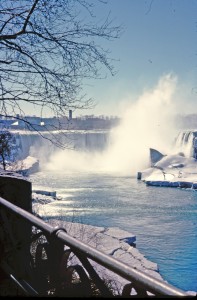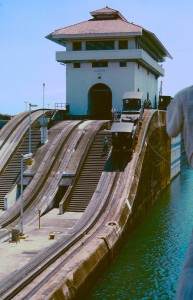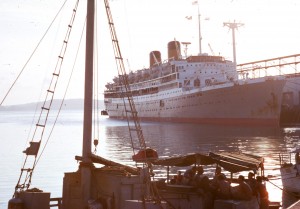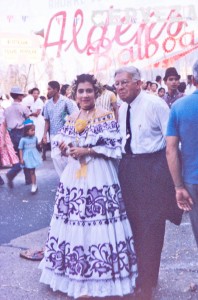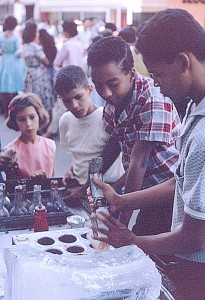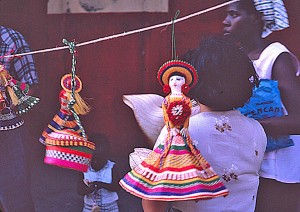Archive for April, 2015
Other people’s weather
An ethereal music filled the air as Tony and I stepped down from the Greyhound bus at Niagara Falls in March 1962, a music so sweet and high it seemed to come from some magical place. I gazed about me. Nothing but bare trees and an almost empty parking lot. A wind that stung my ears. Then I saw them: icicles, many inches long, hanging from every twig and tinkling against each other with every gust.
Growing up in the subtropical north of New Zealand, I did not see snow until I was an adult. Our winters had heavy rain and an occasional frost, enough to whiten the grass and form thin sheets of ice on puddles. But nothing like this: the gigantic falls themselves half frozen and the temperature the coldest I had ever known. Historical records tell me it was probably about 30°F. (though the wind chill factor would have made it seem colder), and that the winter was pretty much a normal one.
We had broken our journey from New Zealand to England in New York to visit my elder sister, who was completing her doctorate at Syracuse University. As we rode the Greyhound bus upstate to Syracuse, what fascinated me as much as the landmarks my sister pointed out were the piles of dirty snow everywhere. I began to comprehend the northern hemisphere stories I had grown up with, where winter was a time of death and darkness, the weather something to be feared, and the spring thaw a time of great rejoicing.
Having recently passed through the tropical miasmas of Panama, I was also discovering that people could learn to live in places where the climate was not friendly, though the strategies they used to deal with the climate sometimes left us puzzled. In Fort Lauderdale, Florida, for example, where our ship had berthed for a day on its way to New York, we were stunned by the difference between the searing heat outdoors and the air-conditioned iciness inside the big stores.
Tony and I realized then that that we were just starting on the great adventure of learning how the rest of the world lives.
Maureen is exploring the contents of an old black filing cabinet in her attic, which contains 55 years of her writing notes
Old age has its advantages
I’m taking a break this week from tales of my youthful travels to share a poem I wrote as homework in a Stanford Online class: 10 Pre-Modern Women Poets, taught by Eavan Boland. This week we studied “Saturday: The Smallpox” by Lady Mary Wortley Montagu. Written in 1747 in the voice of Flavia, a young beauty whose face is disfigured by the disease, the poem is a sad satire on the priorities of that era’s fashionable society. Our assignment was to write a poem using the heroic couplet form in which “Saturday: The Smallpox” was written.
Lady Mary, who was herself afflicted with smallpox, was a pioneer in vaccination for this dreaded disease. I find it particularly discouraging that 267 years later, people are still arguing about the value of vaccination against measles, a disease that nearly killed my father when he was a child.
However, my poem isn’t about the ravages of disease, but rather the emphasis on fashion still rampant today. It was a lot of fun to write.
A Grandmother Responds to Flavia
Advancing age has this one recompense,
That I can clothe myself with common sense.
Invisible already to the young,
I’m from the prison of convention sprung,
At last to dress as I have lately dressed,
I don’t wear heels; I’ve never seen the point
Of teetering at risk to ankle joint.
My fingernails are bare of chip-prone paint,
My hair goes where it wills, without restraint.
When grayness first revealed itself, I bought
Some dye, but soon discovered what I thought
Was beauty was instead a bathroom mess,
Despite my brave attempts at carefulness.
For lack of make-up, blame my allergies,
My nose rubbed naked every time I sneeze.
For lack of lipstick, blame Ms Magazine,
Which in the Seventies proclaimed with spleen
That face paint was an INEQUALITY;
If men don’t have to do it, why should we?
So now my silver hair surrounds a face
Where age’s wrinkles have an honored place.
I am content with plainness; jeans and boots
Shall walk me earthward to my simple roots.
The Mechanical Mules of Panama
My father had a lifelong love affair with things mechanical. When he was in his seventies, I sat him down with a tape recorder. One of his memories was of passing through the Panama Canal. The year was 1920, six years after the canal was officially opened. Dad was eight years old, traveling from New Zealand with his parents and younger siblings to visit relatives back in England. He told me: “I was fascinated with these … I think they call them donkeys. A locomotive type of thing that ran on a rack – rails and rack drive, and those things pulled the ship through from one lock to the other. We had to climb up the steep climb at the end of the lock up to the next level or down.“
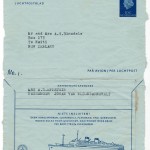 Standing at the rail of the “Johan von Oldenbarnevelt” in 1962, I shared Dad’s enthusiasm. In a letter to parents I wrote: “I did not realise how exciting [going through the canal] would be. It is an incredible piece of engineering, and extremely efficiently run by the Americans. We got up on deck just as we arrived at the first lock, with Balboa still in the distance, so we really saw the whole trip. We were pulled through the canal by teams of little trains called mules, that ran on a cogged track. It only took ten minutes for the huge locks to fill and empty. It was more impressive too because several other ships were going through the other way at the same time – as we went down they went up, and vice versa. From the time we approached the canal we saw lots of big ships – a wonderful change after seeing nothing at all but sea across the Pacific.“
Standing at the rail of the “Johan von Oldenbarnevelt” in 1962, I shared Dad’s enthusiasm. In a letter to parents I wrote: “I did not realise how exciting [going through the canal] would be. It is an incredible piece of engineering, and extremely efficiently run by the Americans. We got up on deck just as we arrived at the first lock, with Balboa still in the distance, so we really saw the whole trip. We were pulled through the canal by teams of little trains called mules, that ran on a cogged track. It only took ten minutes for the huge locks to fill and empty. It was more impressive too because several other ships were going through the other way at the same time – as we went down they went up, and vice versa. From the time we approached the canal we saw lots of big ships – a wonderful change after seeing nothing at all but sea across the Pacific.“
Dad mentioned seeing an alligator on the bank of Lake Gatun. I did too. My letter continues: “Through the centre of the canal we go through a big artificial lake with dozens of islands covered with jungle. Saw at least two alligators, and many beautiful birds. We were served lunch up on deck so that we wouldn’t miss anything – at the time we were going through the Gatun Locks, which is the biggest group – three locks together.
“The countryside changes very much through the canal. On the Panama side it is all lumpy hills, some of them quite high – the Gaillard cut goes through a fairly low part – about 250 ft. Then on the other side you descend to steamy swamps – now fortunately cleared of the mosquitos that ruined the first attempt at making a canal – the remains of the French project are still visible in parts. Even though this is the dry season, the jungle still looked hot and sticky – I would hate to be there in the wet season.”
The ill-fated French attempt to build a canal began work in 1881, but ground to a halt in 1884 because of engineering problems and high mortality due to disease. The United States took over in 1904. A decade later, by far the largest American engineering project to date was completed, and the canal was officially opened in August 1914.
As the JVO slipped smoothly through the canal, I felt I was part of history, both of the canal itself and of my own family, as I followed my father’s journey and shared his enthusiasm for those mechanical mules.
All photographs are by Tony Eppstein.
Maureen is exploring the contents of an old black filing cabinet in her attic, which contains 55 years of her writing notes
Encountering Carnival in Panama
Panama City, March 1962
I had no idea that we’d arrive in Panama during Carnival. Even as our ship sidled into port at the end of the Pacific crossing, we could hear the sounds of it, the ramshackle city pulsing to a beat like none I’d ever heard. Once docked and allowed to disembark, we passengers pushed our way through dense crowds of people, among which wove decorated floats, costumed dancers, bands crowded onto the beds of battered trucks, men on the street beating drums or, lacking drums, the metal sides of the trucks, all singing and shouting to the heady Latin American rhythms. Sometimes a figure in fantastic costume would pass, surrounded by a group of friends singing and shouting together.
Everyone dresses up for Carnival. I was fascinated to see women wearing the pollera, the Panamanian national costume. Spanish in origin and atmosphere, the dress is of white cambric, embroidered in a bold floral pattern in a contrasting color, usually red, black or blue, each frill trimmed with a border of hand-made lace.
At roadside stalls we watched Panamanian boys scrape blocks of ice for the local sweet. They pressed the ice shavings into a paper cup, and poured over it a bright colored syrup and condensed milk. A bit tasteless, but very refreshing.
Passengers had been warned before we disembarked about the level of crime on Panama’s streets. There’s a hint of bravado in my letter to parents: “You just didn’t go into the side streets, or you would be unlikely to come back alive. Pickpockets everywhere. We were either lucky or careful (or both) but many of the passengers had purses, wallets or cameras stolen.”
What I didn’t write about was the effect on me of the incessant drums, the shouts and snatches of tune, the rhythm syncopated, hypnotic. I wanted to drown in it, swirl with the dancers forever into the glittering ocean of color and sound. But like the hawsers holding the ship to the dock, my past tethered me: syrupy fifties songs about marriage and children, strictures on proper behavior, appropriate dress. We wandered in the crowd for a day, then moved on.
All photographs are by Tony Eppstein.
Maureen is exploring the contents of an old black filing cabinet in her attic, which contains 55 years of her writing notes and memorabilia.
